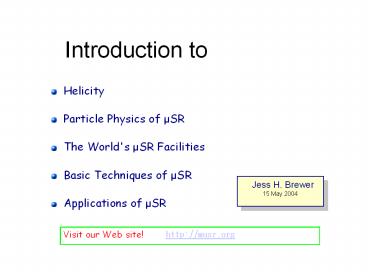Introduction%20to - PowerPoint PPT Presentation
Title: Introduction%20to
1
Introduction to
- Helicity
- Particle Physics of µSR
- The World's µSR Facilities
- Basic Techniques of µSR
- Applications of µSR
Jess H. Brewer 15 May 2004
Visit our Web site! http//musr.org
2
Suppose you sign up your home computer for the
SETI search and the data they give you to analyze
contains this message
We of Barnard's Star II have been studying your
Earth civilization for decades and have now
deciphered your language, units of measurement
and cultural conventions by watching your
TV broadcasts. We would like to begin trading
with Earth, but we wish to negotiate exclusively
through the first person to receive this
message. Our specialty is manufacturing metal
fasteners (nuts and bolts) and we will send you a
shipment to sell for us at 10 of standard Earth
prices as soon as we receive your message
explaining the difference between right-handed
and left-handed threads.
What message would you send to land this
entreprenuerial plum?
3
left handed negative helicity
right handed positive helicity
4
Pion Decay
? ? ? ??
Some pions stop in the skin of the primary
production target. They have zero linear
momentum and zero angular momentum.
Conservation of Linear Momentum The ? is
emitted with momentum equal opposite to that
of the ?? .
Conservation of Angular Momentum ? ?? have
equal opposite spin.
Weak Interaction Only left-handed ??'s
are created.
Thus the emerging ? has its spin
pointing antiparallel to its momentum direction.
mirror
X
5
What's a PION ? An unstable elementary
particle (mean lifetime tp 26 ns) made when
protons hit nuclei. Nuclear glue (Yukawa,
1937) Mass intermediate between electron and
proton, hence called a meson. No spin. Three
types p, p0, p- ? ? ? ??
What's a MUON ? A slightly more stable
particle (mean lifetime t? 2.2 µs) µ-
heavy electron (mµ 207 me) µ
light proton (mµ mp/9) Spin
precesses in a magnetic field µ ? e ne
nµ (asymmetrically)
6
TRIUMF
7
Lower half of TRIUMF cyclotron magnet 1972
Inside TRIUMF cyclotron today
8
Primary Production Target
500 MeV
?? 26 ns
4.1 MeV ?? 2.2 ?s
9
Pion Decay
? ? ? ??
A pion stops in the skin of the primary
production target. It has zero linear momentum
and zero angular momentum.
Conservation of Linear Momentum The ? is
emitted with momentum equal opposite to that
of the ?? .
Conservation of Angular Momentum ? ?? have
equal opposite spin.
Weak Interaction Only left-handed ??'s
are created.
Thus the emerging ? has its spin
pointing antiparallel to its momentum
direction, giving
mirror
X
spin polarized muons.
10
Muon Decay
Neutrinos have negative helicity, antineutrinos
positive. An ultrarelativistic positron behaves
like an antineutrino. Thus the positron tends to
be emitted along the muon spin when ?e and ?µ go
off together (highest energy e ).
11
?-Decay Asymmetry
Angular distribution of positrons from ?-decay.
The asymmetry is a 1/3 when all positron
energies are detected with equal probability.
12
What happens when you try to tip a top? Instead
of tipping over the way you twist, it moves
sideways! This is how you steer a bicycle,
though you never think about it. If gravity
keeps trying to tip over the top, it keeps
slipping away sideways. This is called
precession.
Many elementary particles (like protons,
electrons muons) have an intrinsic spin like a
little top that never needs winding. When a
magnetic field tries to tip them over, guess
what we get!
magnetic field
Spin Precession
13
Visit our Web site! http//musr.org
- The World's µSR Facilities
- Basic Techniques of µSR
- Applications of µSR
14
Where in the World is µSR?
15
Transverse Field (TF)-µSR
Typical time spectrum (histogram)
16
Zero Field (ZF)-µSR
Typical asymmetry spectrum ( B F ) ------ ( B
F )
17
Brewer's List of µSR Acronyms
Longitudinal Field
Transverse Field
Zero Field
Avoided Level Crossing Resonance
Fourier Transform µSR
Muon Spin Echo
Muon Spin Resonance
18
Themes in µSR
- Muonium as light Hydrogen
- (Mu µe-) (H pe-)
- Mu vs. H atom Chemistry
- - gases, liquids solids
- - Best test of reaction rate theories.
- - Study unobservable H atom rxns.
- - Discover new radical species.
- Mu vs. H in Semiconductors
- - Until recently, µ SR ? only data on
- metastable H states in semiconductors!
The Muon as a Probe
- Probing Magnetism unequalled sensitivity
- - Local fields electronic structure ordering
- - Dynamics electronic, nuclear spins
- Probing Superconductivity (esp. HTcSC)
- - Coexistence of SC Magnetism
- - Magnetic Penetration Depth ?
- - Coherence Length ?
- Quantum Diffusion µ in metals (compare H)
Mu in nonmetals (compare H).
19
(No Transcript)
20
(No Transcript)































